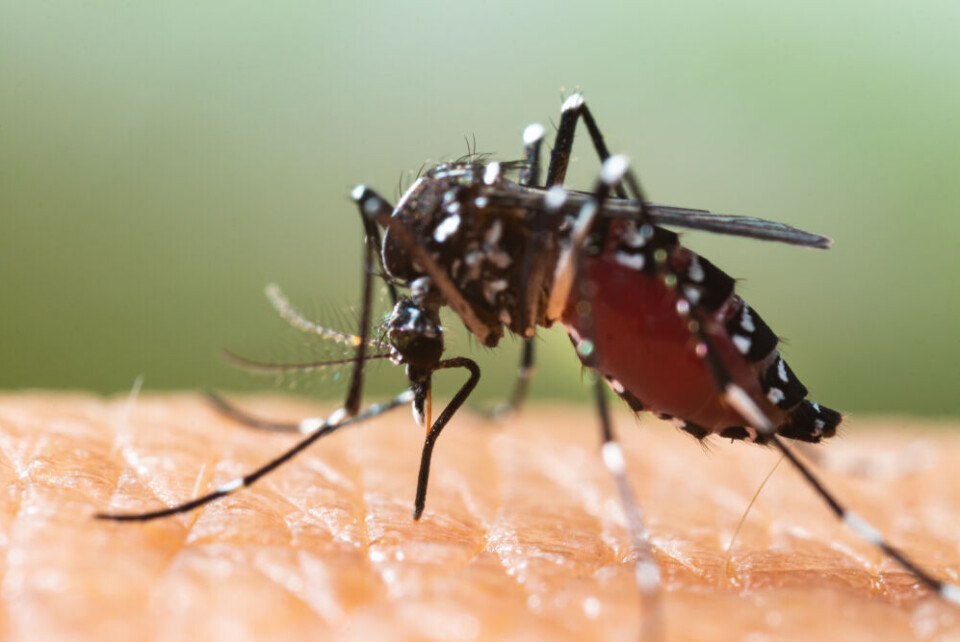-
‘No evidence third party involved’ in deaths of British couple in south-west France
Investigators update The Connexion on Dawn Kerr and Andrew Searle case
-
MPs push to remove low emission zones in France
Critics say the zones penalise lower-income households, but the government has warned abolishing them could cost billions
-
Trump tariffs: Americans in France hit by dollar drop
Europe has said the tariffs will cause the economy to ‘massively suffer’ as France plans retaliation
Increase in tiger mosquitoes in France leads to more cases of dengue
Why are there more mosquitoes, and what are the common symptoms of dengue to look out for?

Cases of dengue fever caught via a mosquito bite are on the rise due to an increasing number of tiger mosquitoes in the country, health authorities and specialists have warned.
This year 18 people in the southern region of Occitanie have been diagnosed with the illness, and increased numbers of cases are also being observed every year in the Mediterranean regions.
These are ‘native cases’ (autochthonous, or autochtones in French), meaning that they are diagnosed in people who have not travelled to an area of the world which is typically associated with dengue.
This means that the patients were infected on French soil.
This has been blamed on rising numbers of tiger mosquitoes; and hotter temperatures due to climate change, which help the mosquitoes proliferate.
It has been mandatory for doctors to report cases of dengue since 2006, and each case requires a health investigation.
In 2022, there were 66 cases of native dengue reported, of which the majority were in Paca (Provence-Alpes-Côte-d'Azur). The second most affected region was Occitanie, where there were 12 cases.
This represented a sharp rise with just 48 cases identified in total between 2010-2021.
Cases set to rise further
Specialists are now warning that native cases of dengue (as well as chikungunya and Zika, which are also spread by tiger mosquitoes) are likely to rise further in coming years.
“The increase in the number of cases, particularly indigenous cases, is due to the growth in the population of mosquitoes, which are the vectors of the infection,” said Dr Charlotte Boullé, infections specialist at the infectious and tropical diseases department at Montpellier University Hospital, to France 3.
“Systematic case-finding and reporting are also playing a role,” she said.
From non-native to endemic
She added that native cases are firstly linked to non-native cases. This is because, to spread the illness, a mosquito must first bite an infected individual.
Dengue is most common in areas including South and Central America, the Caribbean, the Philippines, parts of Southeast Asia, India, and Bangladesh.
Severe outbreaks are also relatively common in Singapore, and in the French overseas territories of Martinique and Guadeloupe.
The number of cases imported into mainland France varies every year. However, the total in 2023 is expected to be significantly higher than that of 2022 (1,099 in 2023 compared to 378 in 2022).
This is mainly due to ongoing epidemics in French overseas territories where infected people visiting or returning to France bring the infection to mainland France.
Dr Boullé warned that increased cases each year - and the continued spread of tiger mosquitoes - could mean that the illness becomes ‘normal’ in France.
She said: “Our fear is that, as the tiger mosquito spreads across mainland France, dengue fever will become an epidemic every year, and ultimately an endemic disease.”
In a recent advisory, the committee for health risks, Covars (le Comité de veille et d'anticipation des risques sanitaires), said that in future, the country can expect to see more cases of dengue and new reports of Zika and chikungunya.
“These [viral illnesses] could become public health problems,” it said.
How can dengue be prevented?
To prevent increased spread, people who return from at-risk countries should take extra steps to protect themselves from mosquito bites for two weeks once they get home, even if they have no symptoms of dengue.
This helps to prevent the virus from spreading via its vector, the tiger mosquito.
A vaccine against dengue already has approval for use in France but it is rarely used. Also, it is currently only allowed for people aged nine to 45 who have a documented history of dengue infection or who live in a dengue area.
In areas where dengue - and growing numbers of tiger mosquitoes - are identified, authorities now tend to carry out anti-mosquito operations.
This typically includes spraying anti-mosquito insecticide and using other anti-mosquito methods in the local environment overnight.
Local residents are warned in advance to stay indoors during the spraying.
How to reduce and stop tiger mosquitoes
The best way to stop the spread of mosquito-borne diseases is to prevent the mosquitoes from becoming attracted to your home or garden.
Read more: Tiger mosquitoes: How you can help stop their spread in France
Read more: France’s mosquito season is here. Here are tips on how to avoid them
Health authority Anses gives the following tips to help with this:
- Regularly empty or remove any stagnant water, including the cups under flower pots, vases, etc., or fill them with sand in order to maintain humidity without stagnant water
- Store buckets, gardening equipment, toys, and other containers away from the rain
- Cover water collection containers with mosquito netting or fabric
- Clean gutters to allow proper drainage
What are the symptoms of dengue?
The most common symptoms are:
- A sudden onset of persistent high fever (>38.5C)
- At least one other clinical sign, such as a severe headache, muscle pain, joint pain, lower back pain, or severe fatigue
Less common symptoms also include:
- Skin rashes
- Eye and/or eye socket pain
- Abdominal pain
- Swollen lymph nodes
Dengue does not typically cause a cough, runny nose, sore throat, breathing difficulties, and/or infected wounds. If you have these issues (even in combination with the symptoms above), it may point to a different condition, not dengue.
Many cases of the illness are asymptomatic, but symptoms can come on between three to 14 days after being bitten.
Around 1% of cases can become more severe, and cause a very high, persistent fever and sometimes-fatal haemorrhaging.
If you believe that you may have dengue you are advised to report it to your doctor as soon as possible even if you have not travelled to an at-risk area.
There is no cure for dengue currently; patients are advised to rest and treat the symptoms.
The vast majority of cases will go away on their own after a few weeks.
Why are tiger mosquitoes spreading in France?
Having first been identified in France in 2004, the insects were initially common in the south, but rising temperatures have seen them spread north. Tiger mosquitoes are now in 71 departments in France, and counting.
Map: Santé.gouv.fr
The weather and global warming are considered major factors. Rainy-but-warm days offer the perfect conditions for the insect to proliferate and spread.
They can start biting in early summer and continue into autumn. And, unlike ‘regular’ mosquitoes, they do not only bite at night.
They tend to bite during the day, and are attracted by stagnant water and warmer temperatures.
“This is a completely normal seasonal dynamic,” said Guillaume Lacour, medical insect expert for Altopictus, a company specialising in monitoring and combating the tiger mosquito, to La Dépêche.
“It is common to see an abundance [of the mosquitoes] until at least mid-October. There was a peak in the south-west between May and July, and since August we've been back to the usual pattern,” he said.
Anna-Bella Failloux, entomologist (insect expert) at the Institut Pasteur has said: “As time goes by, the mosquito is making its way to the north of the country.
“This is because the climate allows it and because it is a mosquito that is hyper-adapted to humans, which means that it will move along with them with transport.”
As of January 1, 2023, their presence has been confirmed in 71 departments.
Insect expert Didier Fontenille said: “Its spread is inevitable…in mainland France it is still mainly just an annoyance. But this could change in years to come.”
Read also
Mosquitoes in France: A scientist's advice for keeping them away
France’s mosquito season is here. Here are tips on how to avoid them
France warns of increased risk of dengue fever from tiger mosquitoes
























